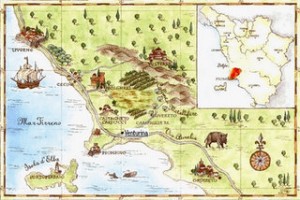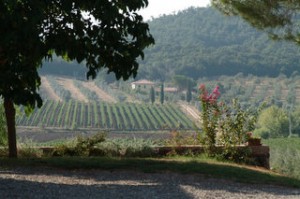Tuscany’s Val di Cornia
I was commissioned by the Italian Trade Commission, a section of the Italian embassy that promotes trade, to deliver a tasting seminar at a May 2010 trade show – the London International Wine Fair. These are my notes for the talk, and my tasting notes below.
Val di Cornia is in the south-west corner of Tuscany, looking out onto the island of Elba in the Ligurian Sea. The vineyard area is small, and centred on the medieval town of Suvereto. It covers just 600 hectares, and is farmed by around 40 wine producers.

Val di Cornia, overlooking Elba
If such a thing is possible in so long an established region, dense with viticultural heritage, as well as one scattered with Etruscan artefacts, Val di Cornia is a youthful area of experimentation which is just beginning to find its own identity among the heavy-weight wine regions of Tuscany.
Indeed the region lies just 30 kilometres south of Bolgheri, which is home to the likes of fabled producers Sassicaia and Ornellaia.
The grape varieties are typically Tuscan, focusing on sangiovese, with some ciliegiolo, both mainstays of Chianti and Chianti Classico. And, following in the Bolgheri example, cabernet sauvignon and merlot started to be planted in the 1980s. Montepulciano also found its way across from Abruzzo, and seems to have settled well on the west coast of central Italy.
Many of the vineyards have a view of the sea, and coastal breezes are said to moderate a little the warmth of the central Italian climate. Rolling hills and patchwork vineyards among the natural woodland environment are the order of the day.

Hillside vineyards
As with other areas of Tuscany, viticulture is focuses on red wines, both the Val di Cornia DOC, and the more flexible IGT Toscana. The DOC has applied for the ‘higher’ appellation of DOCG, and the producers are hoping to hear a result by the end of this year.
The region is also making a speciality of traditional sun-dried sweet passito wines, one red from the aleatico grape, and one white from the ansonica grape. The latter is more commonly found in Sicily where it’s known as inzolia.
Tasting notes, London, May 2010
- These are all top end cuvées from this region.
- They’re all are in the rich, full-bodied genre of central Italy.
- The alcohol is also fairly typical for a central Mediterranean climate, at 14% to 14.5% and throughout, the alcohol is balanced and integrated. In none of the wines tasted did alcohol appear as a separately noticeable item.
- What marks these wines out is that they retain an attractive degree of freshness and acid backbone, across the board. This also helps to lift the fragrant aspects of the wines.
- They are also marked out by plentiful, rich tannins that have a certain sweetness and lushness to them, while retaining a dry, ‘refreshing’ quality.
- All the wines showed enviable levels of richness and concentration, effectively balanced by the lifting, freshening acidity and tannins.
Az. Agr. Macchion dei Lupi, Esperienze 2007, Toscana Rosso IGT
14.5%. 70% cabernet sauvignon, 30% sangiovese. 1,800 bottles made.
Crunchy black cherry, youthful with black cherry tune expression. Quite perky, alcohol balanced, as with others so far. Medium weight with plentiful ripe, soft tannin amid blackcurrant torrents, sweet core of super ripe fruit, big, and supple and mouthfilling, sweet toasty oak surround-sound.
Az. Agr. Giomi Zannoni, Rodantonio, Val di Cornia sangiovese DOC 2006
14%. 100% sangiovese. 50 year old vines. 3,000 bottles produced.
Rich, dark, black pepper spice, smooth attack, full and sweet, quite lush fruit, warm allspice oakiness. Nice fruit/spice balance, with supple tannins. Spicy-dry richness and sweet fruit combine with more classic black tea savouriness of sangiovese. A complexing bitter chocolate note adds texture to the mid palate. Retains its acid freshness alongside the supple texture and fruit density. Good.
Az. Agr. Bulichella, Coldipietrerosse, Val di Cornia Suvereto DOC 2006
14%. 80% cabernet sauvignon and 20% merlot
Warm, baked blackcurrant fruit, blackberry compote, sweet fruit, still with backbone of freshness, soft and lush tannins which are characteristically dry. Sweet fruit, dark bramble with warm juiciness and warming sensation of southern Mediterranean grapes, with their baked concentration, and ripe, sweet chewiness to the supple tannins.
Az. Agr. Rigoli, Assiolo 2006, Toscana Rosso IGT
13.5%. 50% merlot, 50% cabernet sauvignon,
Dense colour, sweet black plum fruit, and blackcurrant leaf nose, some sweet complexity on the nose, lush, sweet-fruited attack. Smooth texture, velvety, seductive tannins, plentiful, blanketing and soft. Has spine to hold the flesh, quite more-ish and seductive in an obvious manner. In that superripe, warm sweet Mediterranean style. Very good.
Az. Agr. Sangiusto, Rosso degli Appiani 2004, Toscana Rosso IGT
14%. 70% sangiovese, 30% montepulciano
Spice, plum, black pepper and cinnamon, lush sweet attack, sweet montepulciano thing going on – plum, dark berries, voluptuous texture, chocolate. Alongside the dried fruits and dark, herby, liquorice thing of sangiovese. Supple tannins, plentiful and not at all chewy, and retaining feshness. Complexing notes of bitter mocha, savoury spice with a hint of fresh steak. Serious, full bodied, big boned and full-fleshed, in a positive manner, wine. Youthful tannins cling to the gums. No particular bottle age showing. Very good.
Az. Agr. S. Agnese, Spirto 2004, Toscana Rosso IGT
14.5%. 60% merlot, 40% cabernet sauvignon
Dense, prickly blackcurrant nose, fresh, bramble, with attractive backbone and framework, chalky dryness to tannins, giving them a refreshing quality. Structural sweet/dry tannin combo. Dark berries, sandalwood from new oak, still to fully soften in. Lush tannins, still with plenty of grip, and very little bottle age showing. Plenty of fruit drive remains, racing with savoury black pepper and caraway seed spice.
Az. Agr. Bulichella, Aleatico 2009, passito, Toscana IGT
13%, 116 g/l RS From the specialist red aleatico grape variety.
Pure, raspberry, strawberry and redcurrant flood into the nose, with faintest herbal, fennel hint. This is pure, fresh, sweet fruit with almost imperceptible tannins, as should be the case for a sweet wine. Elegant, focused, in a pure, primary fruit style. silky smooth texture and long-tasting.
From 35 year old vines around Suvereto. This made 50% traditionally from sun-dried aleatico grapes. The other 50% were dried in a de-humidified room at 9-11°C for 20 to 25 days. The latter helps retain greater freshness and purity.
Az. Agr. Rigoli, Magistro 2006, Passito di Ansonica, Val di Cornia DOC
14%, 200g/l RS; 5.6 g/l TA. From the specialist white ansonica (aka inzolia) grape variety.
Complex nose of coffe beans, walnut, citrus pith and fig. The palate comes in with honey, melted chocolate, caramel and toffee lushness, with honeysuckle and a tropical sensation to the fruit. An oxidative style that retains considerable freshness in its lush, dense, layered complexity. Long finish. A meditative wine with which to put the world to rights.
These grapes are dried for 45 to 50 days, under a plastic tunnel in case of rain. The sides are opened when it’s dry to ventilate as well as expose the grapes to the sun.



